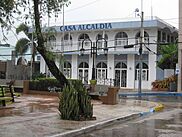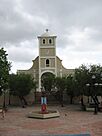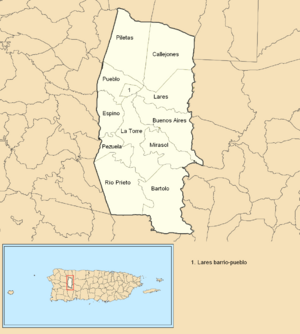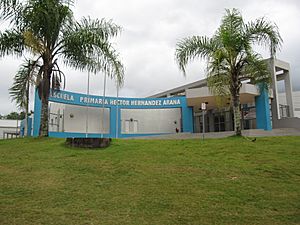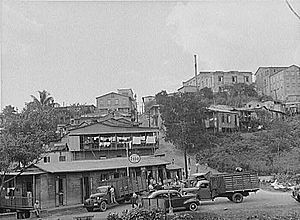Lares, Puerto Rico facts for kids
Quick facts for kids
Lares
Municipio Autónomo de Lares
|
|||
|---|---|---|---|
|
Town and Municipality
|
|||
|
From top, left to right: Lares city hall in downtown Lares; Parroquia del Glorioso Patriarca San José (Parish of the Glorious Patriarch Saint Joseph); Plaza de la Revolución (Revolution Square); Hacienda Lealtad (Loyalty Plantation); and Panoramic mountainous views from barrios Mirasol and Piletas
|
|||
|
|||
| Nicknames:
Ciudad del Grito (The Town of The Cry), Altar de la Patria (High of the Fatherland), La Capital de la Montaña (Capital of the Mountains)
|
|||
| Anthem: "En las verdes montañas de Lares" (In the green mountains of Lares) | |||

Map of Puerto Rico highlighting Lares Municipality
|
|||
| Sovereign state | |||
| Commonwealth | |||
| Settled | 1824 | ||
| Founded | April 26, 1831 | ||
| Founded by | Juan Francisco de Soto | ||
| Barrios | |||
| Area | |||
| • Total | 61.64 sq mi (159.6 km2) | ||
| • Land | 61.45 sq mi (159.2 km2) | ||
| • Water | .09 sq mi (0.2 km2) | ||
| Population
(2020)
|
|||
| • Total | 28,105 | ||
| • Rank | 45th in Puerto Rico | ||
| • Density | 455.95/sq mi (176.045/km2) | ||
| Demonym(s) | Lareños | ||
| Time zone | UTC−4 (AST) | ||
| ZIP Codes |
00669, 00631
|
||
| Area code(s) | 787/939 | ||
| Major routes | |||
Lares is a mountain town and municipality located in the central-western part of Puerto Rico. It sits among beautiful mountains, north of Maricao and Yauco. To its east are Hatillo, Utuado, and Adjuntas. To its west are San Sebastián and Las Marias.
Lares is known for its cool, breezy mountain air. It has charming Spanish-style churches and small shops in its downtown area. It's about 1.5 hours away from Puerto Rico's capital, San Juan, by car.
In 1868, Lares became famous for the Grito de Lares. This means "The Cry of Lares." It was an uprising by people who wanted Puerto Rico to be independent from Spain. Even though it didn't last long, it's a very important event in the history of the island. The flag used during this revolt, called the Bandera del Grito de Lares, is now the official flag of Lares.
Contents
History of Lares
Lares was officially founded on April 26, 1831. The process to create the town started in 1824 and was led by Juan Francisco de Soto Mayor. The town was named after an early settler, Don Amador de Lariz, a Spanish nobleman.
Before it became its own town, Lares was a barrio (a type of neighborhood or ward) of San Sebastián del Pepino. People in Lares had to travel a long way to go to church and do business in San Sebastián. Spanish law allowed a barrio to become a separate municipality if it was far enough from the nearest church and had enough families. After seven years of effort, Lares became its own municipality.
Geography and Natural Features
Lares is a mountainous area in the central-western part of Puerto Rico. It covers about 61.64 square miles. Most of this area is land, with a small amount of water.
Caves to Explore
Lares is home to 10 caves. Two of these are Cueva Machos and Cueva Pajita, both found in the Callejones barrio.
Barrios and Communities
Like all towns in Puerto Rico, Lares is divided into smaller areas called barrios. The main town buildings, central square, and large Catholic church are in the barrio known as "el pueblo".
Here are the 12 barrios of Lares:
- Bartolo
- Buenos Aires
- Callejones
- Espino
- Lares
- Lares barrio-pueblo
- La Torre
- Mirasol
- Pezuela
- Piletas
- Pueblo
- Río Prieto
Barrios are further divided into even smaller areas called sectores (sectors). These can have different names like urbanización or barriada.
Some communities in Lares are called Comunidades Especiales de Puerto Rico (Special Communities). These are areas where people might face challenges. Some of these in Lares include Castañer, Cerro Avispa, Comunidad Anón, Comunidad Arizona, Comunidad El Bajadero, Comunidad Peligro, and Seburuquillo.
Fun Things to See and Do
Lares has several interesting places to visit:
- Callejones Site
- Hacienda Collazo
- Hacienda El Porvenir
- Hacienda Lealtad
- Hacienda Los Torres
- Heladería de Lares — a famous ice cream shop!
- Mirador Mariana Bracetti
- Parque El Jíbaro
Festivals and Events
Lares celebrates its main festival, the Fiestas Patronales de San Jose, in December. This is a religious and cultural event. It usually has parades, games, local crafts, fun rides, and delicious regional food. You can also enjoy live music performances by famous artists.
Other exciting festivals in Lares include:
- Banana Festival – in June
- Lares Festival – in September
- Rábano Estate Festival – in October
- Almojábana Festival – in October
Sports in Lares
Lares has a professional volleyball team called Patriotas de Lares (Lares Patriots). This team has won 3 championships: in 1981, 1983, and 2002. They have had both local and international players on their team.
Economy and Jobs
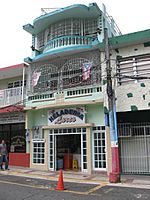
The economy of Lares mainly relies on farming. Farmers here grow crops like bananas, coffee, oranges, and tomatoes.
Tourism is also important for Lares. The Heladeria de Lares (Lares Ice Cream Shop) is very famous across Puerto Rico. It's known for its unique ice cream flavors, like rice and beans!
After Hurricane Maria hit the island in 2017, many people moved away from Lares. However, there are efforts to help the community. In 2016, new homes were built for farmers and their families. These families grow coffee, bananas, and other crops to sell to local markets and restaurants.
Population of Lares
| Historical population | |||
|---|---|---|---|
| Census | Pop. | %± | |
| 1900 | 20,883 | — | |
| 1910 | 22,650 | 8.5% | |
| 1920 | 25,197 | 11.2% | |
| 1930 | 27,351 | 8.5% | |
| 1940 | 29,914 | 9.4% | |
| 1950 | 29,951 | 0.1% | |
| 1960 | 26,922 | −10.1% | |
| 1970 | 25,263 | −6.2% | |
| 1980 | 26,743 | 5.9% | |
| 1990 | 29,015 | 8.5% | |
| 2000 | 34,415 | 18.6% | |
| 2010 | 30,753 | −10.6% | |
| 2020 | 28,105 | −8.6% | |
| U.S. Decennial Census 1899 (shown as 1900) 1910-1930 1930-1950 1960-2000 2010 2020 |
|||
The people of Lares, like most of Puerto Rico, have roots in the Taíno Indians. Later, many immigrants from Spain settled in the central highlands. These Spanish settlers, especially from Andalusia, the Canary Islands, and Extremadura, became the main group of Jíbaros (white peasant farmers) on the island. Their influence is still seen in the Spanish language spoken and the Spanish-style buildings in the city.
Education in Lares
The Héctor Hernández Arana Primary school is an important school located in Lares.
Symbols of Lares
The municipality of Lares has its own official flag and coat of arms.
The Lares Flag
The flag of Lares has a special history. It comes from the 1868 revolt against Spanish rule, known as the Grito de Lares. The flag was designed by Dr. Ramón Emeterio Betances, the leader of the revolt. It was sewn by Mariana Bracetti, another revolutionary leader.
The flag looks like the Dominican Republic flag from 1844-49. This shows the rebels' dream of joining with the Dominican Republic and Cuba to form one nation. The flag has a white cross in the middle. The top sections are blue, and the bottom sections are red. There is a white five-pointed star in the top left blue section.
The Lares Coat of Arms
The Coat of Arms of Lares also features a white cross in the center. It divides the shield into four parts: two blue sections at the top and two red sections at the bottom. In the top left blue section, there is a white five-pointed star. A chain surrounds the shield. Around the shield, on a scroll and ribbon, are the words: "Lares Ciudad del Grito." This phrase means "Lares, City of the Cry," and it clearly identifies the municipality of Lares.
Transportation
Puerto Rico State Route 111 is a main road that helps people get to and from Lares. The town also has 15 bridges.
Famous People from Lares
Many talented people come from Lares, including:
- Jose Feliciano – a famous singer, composer, and guitarist, known for the song "Feliz Navidad".
- Lolita Lebrón – a Puerto Rican nationalist.
- Denise Quiñones – who won the Miss Universe title in 2001.
- Luis Hernández Aquino
- Odilio González – a well-known Puerto Rican singer, guitarist, and composer, also called "El Jibarito de Lares."
Images for kids
See also
 In Spanish: Lares (Puerto Rico) para niños
In Spanish: Lares (Puerto Rico) para niños


